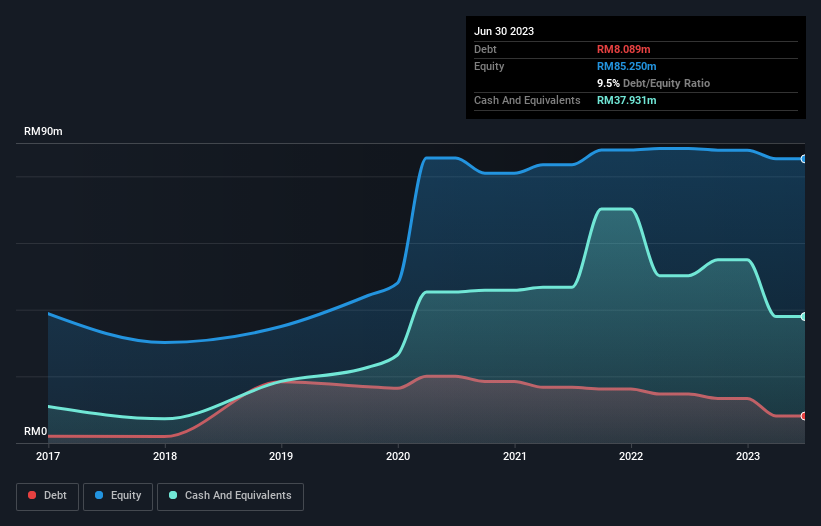- Hong Kong
- /
- Professional Services
- /
- SEHK:1463
Does C-Link Squared (HKG:1463) Have A Healthy Balance Sheet?
The external fund manager backed by Berkshire Hathaway's Charlie Munger, Li Lu, makes no bones about it when he says 'The biggest investment risk is not the volatility of prices, but whether you will suffer a permanent loss of capital.' When we think about how risky a company is, we always like to look at its use of debt, since debt overload can lead to ruin. We note that C-Link Squared Limited (HKG:1463) does have debt on its balance sheet. But is this debt a concern to shareholders?
Why Does Debt Bring Risk?
Debt and other liabilities become risky for a business when it cannot easily fulfill those obligations, either with free cash flow or by raising capital at an attractive price. If things get really bad, the lenders can take control of the business. However, a more usual (but still expensive) situation is where a company must dilute shareholders at a cheap share price simply to get debt under control. Of course, plenty of companies use debt to fund growth, without any negative consequences. The first thing to do when considering how much debt a business uses is to look at its cash and debt together.
See our latest analysis for C-Link Squared
What Is C-Link Squared's Net Debt?
You can click the graphic below for the historical numbers, but it shows that C-Link Squared had RM8.09m of debt in June 2023, down from RM14.7m, one year before. But on the other hand it also has RM37.9m in cash, leading to a RM29.8m net cash position.

How Healthy Is C-Link Squared's Balance Sheet?
We can see from the most recent balance sheet that C-Link Squared had liabilities of RM7.16m falling due within a year, and liabilities of RM5.99m due beyond that. Offsetting these obligations, it had cash of RM37.9m as well as receivables valued at RM19.7m due within 12 months. So it actually has RM44.5m more liquid assets than total liabilities.
This surplus suggests that C-Link Squared has a conservative balance sheet, and could probably eliminate its debt without much difficulty. Succinctly put, C-Link Squared boasts net cash, so it's fair to say it does not have a heavy debt load! There's no doubt that we learn most about debt from the balance sheet. But you can't view debt in total isolation; since C-Link Squared will need earnings to service that debt. So if you're keen to discover more about its earnings, it might be worth checking out this graph of its long term earnings trend.
In the last year C-Link Squared had a loss before interest and tax, and actually shrunk its revenue by 16%, to RM100m. That's not what we would hope to see.
So How Risky Is C-Link Squared?
By their very nature companies that are losing money are more risky than those with a long history of profitability. And we do note that C-Link Squared had an earnings before interest and tax (EBIT) loss, over the last year. And over the same period it saw negative free cash outflow of RM5.8m and booked a RM4.7m accounting loss. Given it only has net cash of RM29.8m, the company may need to raise more capital if it doesn't reach break-even soon. Overall, its balance sheet doesn't seem overly risky, at the moment, but we're always cautious until we see the positive free cash flow. When analysing debt levels, the balance sheet is the obvious place to start. However, not all investment risk resides within the balance sheet - far from it. For example - C-Link Squared has 1 warning sign we think you should be aware of.
If you're interested in investing in businesses that can grow profits without the burden of debt, then check out this free list of growing businesses that have net cash on the balance sheet.
New: AI Stock Screener & Alerts
Our new AI Stock Screener scans the market every day to uncover opportunities.
• Dividend Powerhouses (3%+ Yield)
• Undervalued Small Caps with Insider Buying
• High growth Tech and AI Companies
Or build your own from over 50 metrics.
Have feedback on this article? Concerned about the content? Get in touch with us directly. Alternatively, email editorial-team (at) simplywallst.com.
This article by Simply Wall St is general in nature. We provide commentary based on historical data and analyst forecasts only using an unbiased methodology and our articles are not intended to be financial advice. It does not constitute a recommendation to buy or sell any stock, and does not take account of your objectives, or your financial situation. We aim to bring you long-term focused analysis driven by fundamental data. Note that our analysis may not factor in the latest price-sensitive company announcements or qualitative material. Simply Wall St has no position in any stocks mentioned.
About SEHK:1463
C-Link Squared
An investment holding company, provides outsourced data and document management services in Malaysia, Singapore, and the People’s Republic of China.
Flawless balance sheet and slightly overvalued.
Market Insights
Community Narratives




